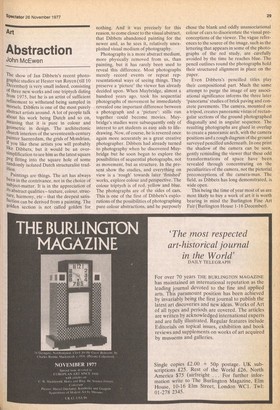Art
Abstraction
John McEwen
The show of Jan Dibbets's recent photographic studies at Hester van Royen (till 10 December) is very small indeed, consisting of three new works and one triptych dating from 1975, but he is an artist of sufficient refinement to withstand being sampled in morsels. Dibliets is one of the most purely abstract artists around. A lot of people talk about his work being Dutch and so on, meaning that it is pure in colour and geometric in design. The architectonic Church interiors of the seventeenth-century painter Saenredam, the grids of Mondrian, If You like these artists you will probably 11.1ce Dibbets, but it would be an oversimplification to see him as the latest square Peg fitting into the square hole of some randomly isolated Dutch structuralist trad !bon.
Paintings are things. The art has always been in the contrivance, not in the choice of s. ubject-matter. It is in the appreciation of its abstract qualities— texture, colour, structure, harmony, etc — that the deepest satisfaction can be derived from a painting. The golden section is not called golden for nothing. And it was precisely for this reason, to come closer to the visual abstract, that Dibbets abandoned painting for the newer and, as he sees it, relatively unexploited visual medium of photography.
Photography is a more abstract medium, more physically removed from us, than painting, but it has rarely been used to reveal this difference. Most photographs merely record events or repeat representational ways of seeing things. They preserve a 'picture' the viewer has already decided upon. When Muybridge, almost a hundred years ago, took his sequential photographs of movement he immediately revealed one important difference between a photograph and a 'picture': stills run together could become movies. Muybridge's studies were subsequently only of interest to art students as easy aids to lifedrawing. Now, of course, he is revered once again more accurately as a great creative photographer. Dibbets had already turned to photography when he discovered Muybridge but he soon began to explore the possibilities of sequential photographs, not as movement, but as structure. In the present show the studies, and everything on view is a 'rough' towards later `finished' works, explore colour and perspective. The colour triptych is of red, yellow and blue. The photographs are of the sides of cars. This is one of the first of Dibbets's explorations of the possibilities of photographing pure colour abstractions, and he purposely chose the blank and oddly unassociational colour of cars to disorientate the visual preconceptions of the viewer. The vague references to the source of the image, such as the lettering that appears in some of the photographs of the red study, are carefully avoided by the time he reaches blue. The pencil outlines round the photographs hold their structured alignment in place on the paper.
Even Dibbets's pencilled titles play their compositional part. Much the same attempt to purge the image of any associational significance informs the three later 'panorama' studies of brick paving and concrete pavements. The camera, mounted on a tripod, creates panoramic vistas of rectangular sections of the ground photographed diagonally and in angular sequence. The resulting photographs are glued in overlap to create a panoramic arch, with the camera positions and a rough diagram of the ground surveyed pencilled underneath. In one print the shadow of the camera can be seen, gently reminding the viewer that these odd transformations of space have been revealed through concentrating on the peculiarities of the camera, not the pictorial preconceptions of the camera-man. The field, as Dibbets has long demonstrated, is wide open.
This being the time of year most of us are most likely to buy a work of art it is worth bearing in mind the Burlington Fine Art Fair (Burlington House 1-16 December).






































 Previous page
Previous page